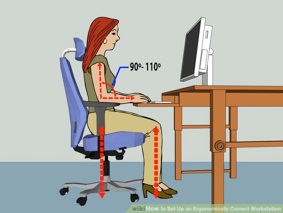Low Back Care Seated Posture

Know Your Mechanics
Preventing Pain and Injury at Work and in Life
Module 1 Low Back
Seated Posture for Back Health
Basic Suggestions for Seated Posture
There is no one ideal seated posture, but these are the best suggestion.
-
•When seated sit up keeping back straight, maintaining three curves to your spine.
-
•Use a chair with lumbar support where lower back is supported.

-
•Distribute your body weight evenly on both hips with feet flat. Do not cross legs.
-
•Bend your knees at a right angle so they are even with or slightly higher than your hips.
-
•Allow your shoulders to relax, not elevated or rounded.
-
•Keep your arms at a comfortable 90-degree angle in a neutral resting position, where upper arm is vertical and forearms are supported.
-
•When seated for a prolonged period try to stand every 20 minutes for 20 seconds. When you stand reach overhead and take a deep breath.
SlideShow for Seated Posture











Detailed Suggestions for Seated Posture
Seated postures are very problematic when it comes to your health. Slumped postures during prolonged sitting causes various issues, one of which is degenerative changes to spinal discs.
Avoid seated spine pressure by maintaining upright seated posture, where you keep the natural three curves to your spine - Did you know that there is almost a 100 p.s.i. intra-discal pressure difference between upright seated posture and a slouched posture. Did you also know that when you sneeze or cough intra-discal pressure increases dramatically, so much so people have strained their back because of it sneeze or a cough.
Ideal Seated Posture
Most ergonomist say there is no one ideal seated posture, but these are the best suggestion.
-
•Sit up with your back straight and your shoulders back maintaining three curves to your spine, where your buttocks touch the back of your chair.
-
•Distribute your body weight evenly on both hips with feet flat. Do not cross legs.
-
•Bend your knees at a right angle so they are even with or slightly higher than your hips (use a foot rest or stool if necessary), where there is a space between the back of your calves and the chair. • Adjust your chair height and work station so you can sit up close to your work where you do not have to reach for anything such as a mouse or phone.
-
•Allow your shoulders to relax, not elevated or rounded • Use an arm rest keeping your arms at a comfortable 90-degree angle in a neutral resting position, where upper arm is vertical. Stretch the top of your head toward the ceiling with chin tucked.
-
•When sitting in a chair that rolls and pivots, don't twist at the waist, instead, turn your whole body.

-
•You may think it is good to stretch forward in your chair, but that just adds stress to the spine. It is better to stand.
-
•When in a car use a back support (lumbar roll) at the curve of your back. Your knees should be at the same level or higher than your hips. Move the seat close to the steering wheel to support the curve of your back. The seat should be close enough to allow your knees to bend and your feet to reach the pedals.
Problem with Ideal Upright Seated Posture - Ideal Seated Postures cannot be maintained for more than ten to 20 minutes. Therefore, alter your seated postures at times. An ergonomic chair is one that facilitates easy posture changes over a variety of joint angles and allows one to stand easily. It is a good idea to stand up every 20 minutes of seated work (see below).
Stand Up for Productivity every 20 minutes for 10-20 seconds - Current research indicates that the ability to vary working postures throughout the day in a well-designed workplace coupled with tailored breaks and exercise can reduce back and other pains by more than 80%. In one study individuals who did not alter their position (non-standers) took an average of 47% more breaks throughout the day and they were 56% longer. Some guidelines suggest performing exercise breaks while seated, and some even go as far as to suggest flexing the torso in a stretch. This can be dangerous! A rest break must consist of the opposite activity to reduce the imposed stressors. A recommended break involves standing from the chair and maintaining a relaxed standing posture for 10 to 20 seconds. The best strategy is to raise arms over your head (see figure a-c) and then push the hands upward to the ceiling and then take a deep breath. By inhaling deeply, one will find that the low back is fully extended. Try to find opportunities for standing like this in your day.
Never do Strenuous Activity after being Seated for Sometime -When your seated for sometime spinal discs migrate backwards and spinal muscles lose their ideal alignment, all of which primes the back for injury. Therefore, never do anything strenuous activity after being seated for sometime. If you have to make sure you ambulate around for several minutes before doing the activity. One of the worst things for an athlete is to be seated on a bench during a game and then be rushed onto the field - the back and for that matter the entire body needs time to adjust.